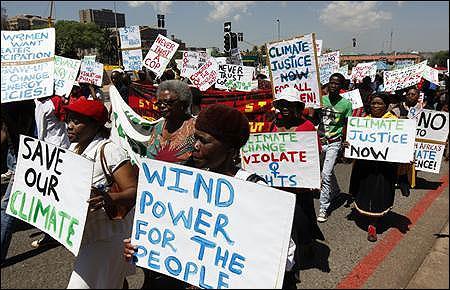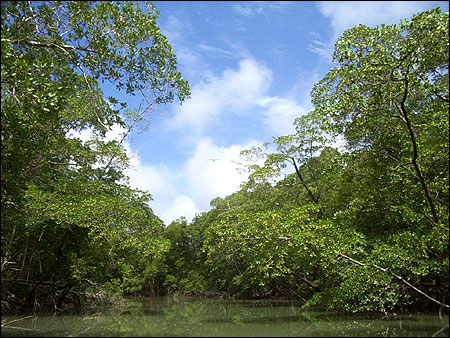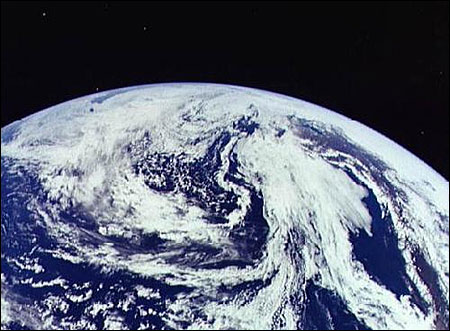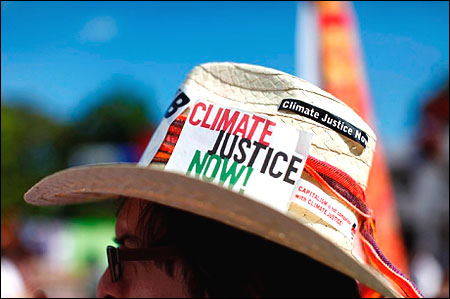 | « Back to article | Print this article |
Averting climate talks disaster: What India should do
The numerous rounds of talks held since the Rio Earth Summit of 1992 in Brazil under the United Nations Framework Convention on Climate Change (UNFCCC) have been called "the most important negotiations ever undertaken in the history of humankind."
This is no exaggeration. Catastrophic, irreversible climate change represents the gravest threat today to human civilisation.
With fast-rising emissions of carbon dioxide and other gases which heat the atmosphere, Planet Earth is hurtling towards disaster, with rapid melting of ice-caps and glaciers, rising sea levels, changes in rainfall patterns, and frequent extreme weather events like ferocious cyclones, epic floods and crippling droughts. Fragile climate balances are breaking down.
The earth can cope with maximum global warming of 1.5 to 2° Celsius (above preindustrial levels). But rising greenhouse gas (GHG) emissions are set to drive warming to 3 to 4° C, even 5° C.
Click on NEXT for more...
Averting climate talks disaster: What India should do
At 3° C global warming, one or more "tipping points" will be crossed, such as such as rapid loss of Arctic summer sea-ice, degradation of the Amazon rainforest, decay of the Greenland ice-sheet, and great instability in the Indian summer monsoon.
Once this happens, the entire climate system changes its character, and remedial action becomes ineffectual.
At 4° C, warn scientists such as the deputy director of Britain's prestigious Tyndall Centre for Climate Change Research, only one-tenth of the world's people will survive.
Climate science is as certain as science can be that the opportunity to limit warming to safe levels will close in this very decade.
In fact, carbon-intensive infrastructure, including power stations, buildings and factories, planned over the next five years will lock the world into a high-emissions trajectory - unless alternatives are explored.
If emissions don't plateau by 2020 and rapidly decline thereafter, the 2° C target will slip out of reach
Thus, negotiations to find a cooperative global solution to the climate crisis by drastically reducing GHG emissions are vital and urgent. There's no time to lose.
Now, every month counts. The longer deep emissions cuts are delayed, the heavier and more unmanageable the future burden.
Click on NEXT for more...
Averting climate talks disaster: What India should do
Logically, the solution must focus on getting those most responsible for causing climate change to shoulder the greater part of the responsibility of remedying it.
The world desperately needs an equitable, effective and enforceable agreement under which different countries, societies and corporations cut their emissions commensurate with their culpability, and their economic and technological capacity for remedial action.
This is the principle of "common but differentiated responsibilities (CBDR) and respective capabilities" enshrined in the UNFCCC.
It is a sign of the abysmal and unforgivable failure of the world's leadership that 16 rounds of UNFCCC negotiations have failed to give full effect to CBDR and deliver a fair, ambitious and binding (FAB) deal, which captures the urgency of climate stabilisation and imposes deep and early emissions cuts on the globe's top polluters.
Click on NEXT for more...
Averting climate talks disaster: What India should do
Now, even the 17th Conference of the Parties (CoP) to the UNFCCC being held in Durban, South Africa is likely to turn out fractious and unproductive of a FAB deal.
Nobody expects it to resolve the many issues under dispute, including who should undertake emissions reductions besides the 40 developed countries of the Global North called Annex 1, what the reductions' magnitude and legal form should be, who should finance the climate actions of the South's poor countries, and how they should be verified.
Under the CBDR principle, the North should take the lead in reducing emissions since it's responsible for three-fourths of the GHGs accumulated in the atmosphere.
It should also financially and technologically support the poorer South's climate actions - as a means of repaying its climate debt.
But the North has baulked at this, and delivered very little in emissions cuts or money.
Click on NEXT for more...
Averting climate talks disaster: What India should do
The Annex 1 countries have not fully met their obligations under the world's sole legally binding agreement, the Kyoto Protocol, under which they were to reduce their 1990-level emissions by an average of only 5 per cent by 2008-12.
The US never ratified Kyoto, and will emit 5 percent more GHGs than in 1990.
Japan, Canada, France, Spain, Australia, and the Netherlands are likely to miss their Kyoto targets, some by wide margins such as 30 per cent.
Many rich countries will meet their targets by hiding behind the former Eastern bloc countries, also included under Annex 1, whose economies and emissions contracted after 1991.
Yet others have shown compliance with Kyoto by buying carbon credits from overseas.
Carbon trading, based on unsound physical premises and dubious economics, has turned out a massive scandal, replete with speculation, over-generous emissions allowances, efforts which would have been undertaken even without credits, misreporting, and downright fictitious projects.
Click on NEXT for more...
Averting climate talks disaster: What India should do
Kyoto's first legally effective period ends next year. And there's bitter contention over negotiating a second period.
Since the Copenhagen conference (2009), the North has even extracted higher emissions reduction pledges from the South than its own.
Its pledges range from near-zero to a maximum of 3.8 billion tonnes (gigatonnes - Gt) of CO2-equivalent by 2020, depending on level of ambition expressed, conditions stated, and leniency of accounting rules.
By contrast, the Southern countries' pledges range from 3.6 to 5.2 Gt. At the higher end, the South pledges 37 percent deeper emissions cuts than the North.
China, India, Brazil, South Africa, Indonesia, Mexico and South Korea have together made 40 percent to 300 percent-plus higher pledges than the top six Northern polluters, including the US, the European Union, Japan, Russia, Canada and Australia.
Smaller and poorer states such as the least developed countries (LDCs) and Alliance of Small Island States (AOSIS) have made more generous commitments than big industrial polluters.
Click on NEXT for more...
Averting climate talks disaster: What India should do
This perversely inverts the CBDR principle and unjustly transfers the burden of climate stabilisation further on to those who are least responsible for climate change, but are first to suffer its effects.
Today's climate talks inherit the toxic legacy of the disastrous Copenhagen summit (2009), and last year's Cancun conference.
The legacy's worst part is the forced transition from binding emissions-cut targets, based on science and equity - in particular, CBDR - to arbitrary, unambitious, even paltry, voluntary national pledges.
The shift was collusively engineered at Copenhagen by the US and the newly formed BASIC (Brazil, South Africa, India, China) group to avert ambitious obligations.
Shamefully, India crossed its own stated "red lines" and became a colluder. The US-sponsored "pledge and review" approach prevailed at Cancun too. This has put the world on course to a likely climate catastrophe.
Click on NEXT for more...
Averting climate talks disaster: What India should do
Thus, it isn't right to blame the developed countries alone for the grim climate crisis and the distrust and bad faith in the climate talks.
The South's "emerging" economies, represented above all by BASIC, must also share the blame, albeit in smaller measure for the mess, but in larger proportion for their rising emissions.
A distinction must be made between BASIC and the rest of the South.
BASIC's emissions are rising much faster than the world's.
Last year, China's emissions rose 10 per cent over 2009, and India's 9 per cent, well above the world's 6 per cent.
Between 1990 and 2009, global CO2 emissions from fuel combustion rose by 37.2 percent and the OECD countries' by 8.2 per cent.
But India's emissions increased by 175.9 per cent, and China's by an even higher 196.8 per cent. Brazil's emissions grew slightly slower, by 68.4 percent, and South Africa's by 53.7 per cent.
Click on NEXT for more...
Averting climate talks disaster: What India should do
Today's China is wholly different from the China of 1992, when the UNFCCC was signed.
Its per capita emissions now almost equal Western Europe's and will reach US levels by 2035.
India can't continue to hide behind its poor to refuse climate obligations indefinitely.
India's emissions are rising not because the needs of the poor are being met, but because the rich are consuming emissions-intensive luxury goods as never before.
Even though it would be wrong to equate BASIC with the North, BASIC will have to take on more climate obligations in the near future.
Many states, including the LDCs and AOSIS - and Afghanistan Bangladesh, Bhutan and Nepal in our own neighbourhood -expect more from these emerging "giants", in keeping with their growing economies, emissions and capacity for climate actions.
Click on NEXT for more...
Averting climate talks disaster: What India should do
India will face tough choices at Durban under a new environment minister largely unfamiliar with the global negotiations, and a Prime Minister who is staunchly pro-US and favours a weak climate deal.
India has to play a dual role: as a member of the G-77 developing-country bloc, and as a BASIC state, while upholding climate equity.
A pivotal equity issue is how to make the North vacate the excessive space it occupies in the global atmospheric commons - at the South's expense.
I argue in my just-released book, The Politics of Climate Change and the Global Crisis: Mortgaging Our Future (Orient BlackSwan), that the climate stabilisation burden can be justly shared on many criteria, not just equal per capita emissions.
At Durban, India must resist the "Copenhagen temptation" - of opposing a FAB deal and supporting a weak, ineffective climate agreement because that would impose no obligations on it. This will harm the Indian people and the global climate.









